
The 'Collective Mind' of the Termite
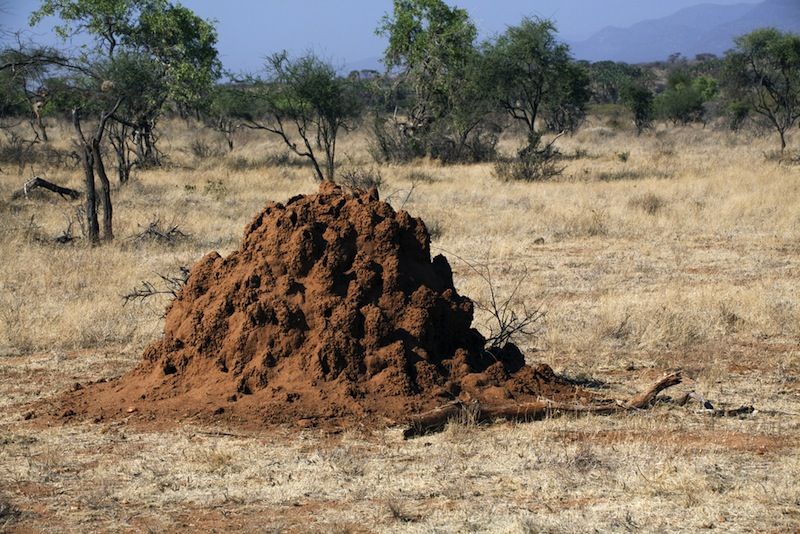
This article was originally published at The Conversation. The publication contributed the article to Live Science's Expert Voices: Op-Ed & Insights.
In Afrikaans, they are called rysmiere, literally “rice ants,” although their name is more commonly rendered into English as “white ants.” They are not ants, though; they’re not even closely related to the ants. In fact, their nearest insect relatives are cockroaches: they are termites.
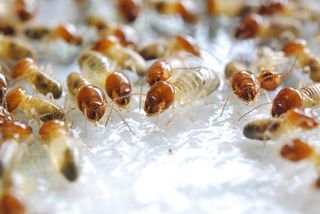
For nearly 20 years, I have been studying the termites of southern Africa. I focus on a particular group of them that builds large above-ground mounds, which are a common sight in the savannas of southern Africa. They are grazers, collectively consuming more grass and bark than all the zebra, gazelles, kudus and giraffes that tourists pay thousands of dollars to come to Africa and photograph.
They are also soil builders. Each colony cycles roughly a quarter-ton of soil annually up through its underground nest and mound, enriching it as it passes through the underground colony – and the multitude of termite intestines that live there. The mounds are like slow-motion “nutrient fountains” that spread their bounty over the sandy soil as wind and rain erode them. Indeed, termites are one of the main reasons why arid savannas are lush grasslands, despite the paucity of water.
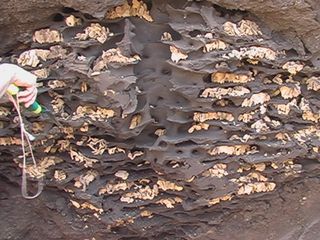
The mound-building termites are also famous for supposedly “air-conditioning” their nests, which are located underground about a meter below the mound. The thought was that the mound was constructed to harness the nest’s waste heat production (about 100 watts) to power a circulation of air between the nest and mound. In this way, the circulating air supposedly exported excess heat and moisture from the nest, keeping it relatively cool and dry: air-conditioned, in a sense.
I came face-to-face with these termites for the first time in 1988, on the fringe of the Kalahari Desert. I had unaccustomed spare time on my hands, so I decided to use it to dig into that conventional wisdom and see how air actually moved in there.
I injected puffs of propane gas into various places and followed where the puffs went: what’s called a “pulse-chase” experiment. After a lot of propane injections, it was clear air flows were not at all what the “settled science” said they should be. The nest is not air-conditioned – the mound controls neither the nest’s temperature or its humidity. Instead, the mound captures energy in wind to stir the mound air and mix it with the nest’s stagnant air, just as you would mix the layers of hot and cold water in a bathtub. This is just what our own lungs do, with the mixing powered by the chest muscles. The termites' clever trick is to power that function with energy in turbulent wind.
Sign up for the Live Science daily newsletter now
Get the world’s most fascinating discoveries delivered straight to your inbox.
The internal tunnel network of the mound facilitates gas exchange between the underground nest and atmosphere. It can be revealed by filling the mound with plaster of Paris and then washing away the soil – what we call endocasting. We can make thin slices to study the mound’s internal structure.
Those initial answers led to many other questions. How do the termites build their mound? How do they “know” collectively what is the “right” mound architecture? How does this help these termites get an adaptive leg up in their harsh environment? Along the way, I have had the good fortune of having many very fine collaborators to help answer these questions: entomologists, engineers, physicists, authors, filmmakers.
Every year, we all try to come together in Namibia for a month of fieldwork. It is a raucous circus of science, simultaneously exhausting and exhilarating, an ephemeral research institute plopped into the wild savannas of northern Namibia.
My own role in all this has been to understand the termites’ collective mind. Putting it that way seems a little far-out, I know, but the mound is actually the product of a rich cognitive intelligence. If we can understand this collective intelligence, we will understand something fundamental about how form becomes function, a question that is central to life itself.
Time-lapse video of termites making repairs to their mound.
You can see the termites’ collective mind at work if you drill a hole in the side of the mound. After about 10 minutes, a few termites will show up and start building a mud wall. Then more will come, and more, and more, until there is a frenzy of little termite masons sealing off that hole.
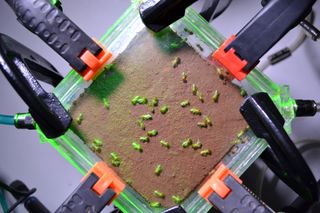
That is a remarkable feat of swarm intelligence. The hole itself is quite a long walk for termites living in the nest, but they must somehow come to know their mound has a hole in it. How? How does a blind termite find the hole? How do they direct their repair efforts to the right place? What calls them off once they are done? How do they even know they are done? These are challenging tasks for tiny insects individually, but collectively they seem to solve them just fine, even when the repair extends far beyond the six-week lifespan of a typical termite worker.
The collective intelligence of the colony is quite real, as real as our own intelligence, and we are far from comprehending either.
That’s why I spend quite a lot of time in a dark room on a farm in Namibia watching termites under a microscope or video camera. To tease out what they are collectively “thinking”, I have fed them little drops of fluorescent dye to see how they distribute water to each other. I have tricked them with little pieces of colored polystyrene that they pick up and move around as if they were grains of sand. I give them choices of different types of soil to see whether they build it up or tear it down. I make them build in pipes or between sheets of glass that distort how they sense their tiny worlds. I have painted little dots of fluorescent paint on their backs so I can follow individuals within their swarm.
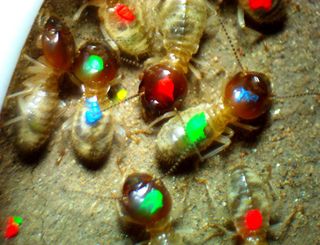
I’ve managed to learn quite a lot from all this watching. For example, termite swarms are prone to cognitive disorders, like a kind of swarm aphasia, akin to a termite speech and comprehension disorder. Tight clusters of termites form that are seemingly oblivious and unresponsive to conditions in the outside world.
There are identifiable termite “personalities.” Some are “initiators,” getting building under way and running around recruiting lazier nestmates to the task, physically prodding them into action if they resist. Some individuals share water avidly with others, devoting 15 minutes or so to sucking up precious water from soil then distributing it to thirsty nestmates.
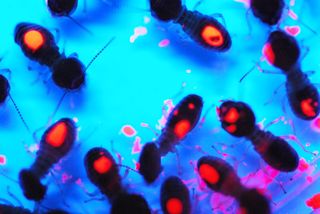
These personality traits can differ between species. One species’ workers will be generous sharers of water, while another species’ workers will be more selfish. One species’ workers will be more attentive to the chemical cues left by nestmates, while another species’ workers will be more attentive to the water content of soils. These translate into different types of mounds. One species will be an “exuberant” builder, throwing up the mound into spectacular tall spires, while another species will be more “restrained” in its building, producing a low conical mound.
When one is deep into experiments and analysis, it’s easy to lose sight of the fact that science is not a method, it is a distinct philosophy of nature. Science is (or should be) prodding nature to give us straight answers about herself. Experiment is one way to get those answers, but simple observation is another. Sometimes nature speaks through observation with a meaning that experiment may not be able to capture, or scientists are willing to hear.
Swarm intelligence provides a case in point: are termites simply little robots, programmed to operate through simple algorithms of behavior? Or is there something special, something vital about them that gives what they do an entirely different meaning?
For a long time, I had thought the former, but I have to say I’m now leaning more toward the latter. What clinched the deal for me was watching swarms of termites settle into what might pass in a Petri dish as a normal setting – familiar soil, a little moisture, a small chip of wood and some fungus from their colony – where there were no swarm aphasias or other signs of cognitive distress.
Termite grooming behavior.
After a while of exploring their little artificial world, the termites would begin to groom one another. It’s a remarkable thing to watch. One termite, the groomer, begins to lick another and then painstakingly works each of the “groomee’s” appendages – legs, antennae, mouth parts – through its mandibles. All this time, the groomee seems almost tranquil: its antennae cease to move, it languidly presents its appendages to the groomer as if to say “now this one.” The grooming can become quite intense, with “grooming stations” forming, groups of termites waiting their turn to be attended by a particularly avid groomer.
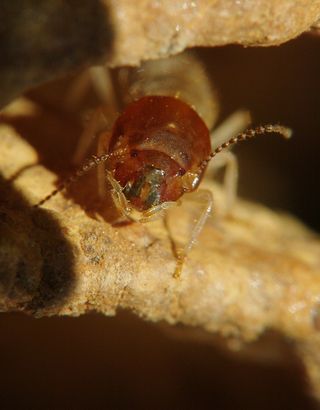
Eventually, it hit me: these are not robots; they are living things with individuality, wants and desires. A robot cannot ever “want” to be groomed or “want” to give water to another or “want” a drink. But termites seemingly do. And this gives termites, both individually and collectively, something like a soul – an animating principle that one does not find in mere machines. It needn’t be some vital “stuff” as the ancients once thought, but still something ineffable that makes life distinct from nonlife.
Scott Turner, Professor of Environmental and Forest Biology, State University of New York College of Environmental Science and Forestry
This article was originally published on The Conversation. Read the original article. Follow all of the Expert Voices issues and debates — and become part of the discussion — on Facebook, Twitter and Google +. The views expressed are those of the author and do not necessarily reflect the views of the publisher. This version of the article was originally published on Live Science.










